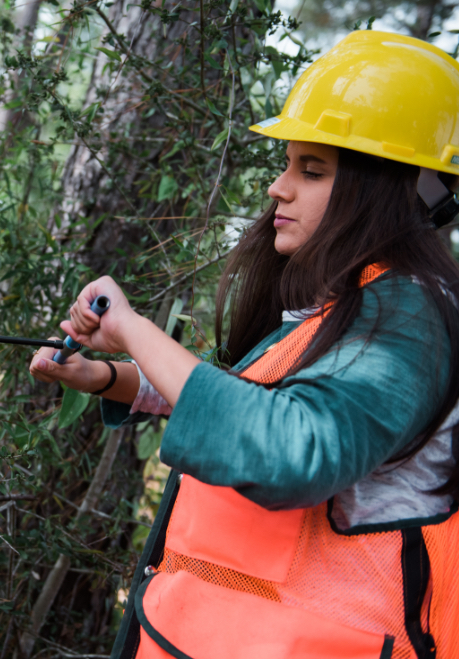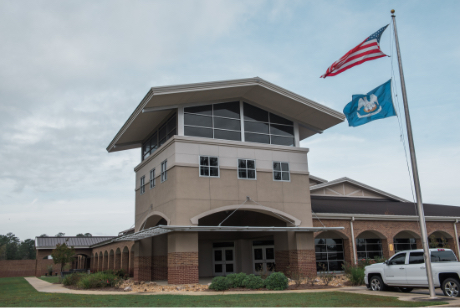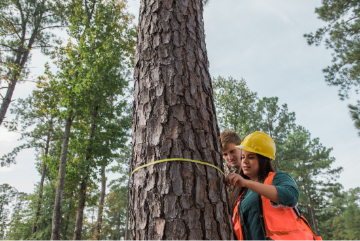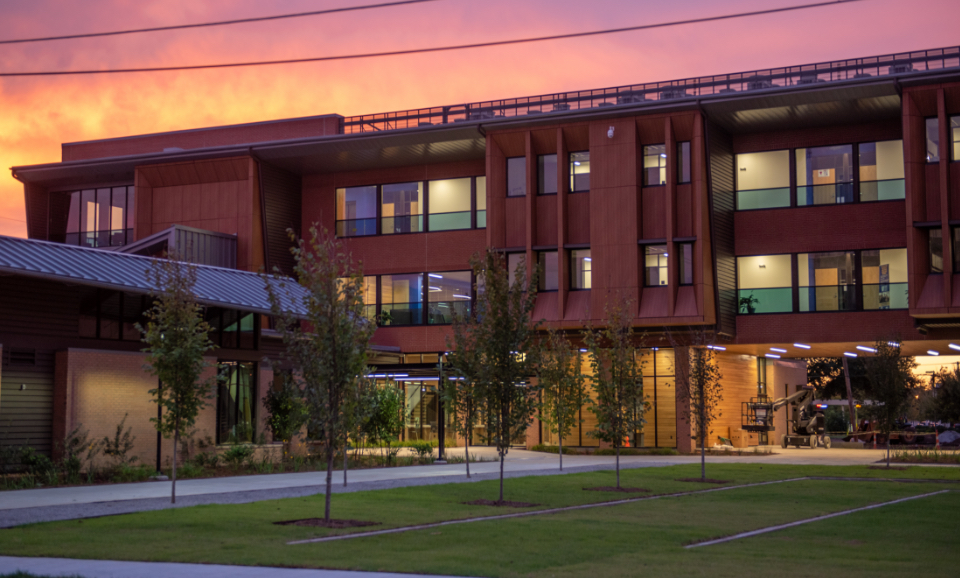WINNFIELD, La. – Tucked into a heavily forested pocket of central Louisiana, the Saline Lake Outpost caters to fishermen angling on the lake for white perch and brim as well as to neighbors looking to grab a carton of milk or a burger without a 17-mile trek to the next-nearest store. One shimmering afternoon in the summer of 2019, patrons’ pickup trucks pulled up past grazing cattle to the corrugated metal shop with an off-kilter marquee sign announcing, “We now have crickets.”
Inside, the clerk in twin braids, Olivia Cohea, greeted each customer cheerfully—perhaps with a “Hey, girl!” or a few words about the day’s fishing prospects—as she rung up beer or soda.
When business slowed, the only sounds were the hum of the fridges and the tireless chirping of crickets in the back room, awaiting their fate as bait, priced at $3.50 for 75. That’s when Cohea, a few days shy of her 19th birthday, would unspool threads of her young life in rural central Louisiana: what it was like to grow up a bystander to her parents’ substance abuse, buffeted by their stints of incarceration; how well known her family’s troubles were; how a teacher once taunted that she’d never make anything of herself, that she would fall prey to a generational curse.

Olivia Cohea greets a customer at the Saline Lake Outpost, where she works while attending college, Winnfield, Louisiana.
That wasn’t much different from remarks she heard at home—that she wasn’t good at school, that maybe she should drop out. And that is exactly what she did in the fall of 2017, early in her senior year of high school, when family drama forced her to switch schools. Cohea checked herself into a half-year residential boot camp run by the Louisiana National Guard. Next, she tried to join the Army but was told she needed to lose weight before doing so.
Then, last January, she signed up for classes to prepare for a high school equivalency diploma at the one-building community college campus in Winnfield, a 20-minute drive away from the home on the lake where she was living with a friend. The Winnfield campus is 1 of 6 rural satellite locations of Central Louisiana Technical Community College (CLTCC), which is headquartered in the small city of Alexandria, on the other side of a 600,000-acre national forest.

Central Louisiana Technical Community College staff and the college’s bobcat mascot attend a community event in downtown Alexandria.
The college has a short history that illuminates how much a rural community can do for young or marginalized people like Cohea when it bets on education as a path to a better life. But this story also shows the flip side of the coin: how decisions of faraway politicians can ripple out to the smallest communities, and how much harm is inflicted when higher education is starved for funding.
It is a story with urgent relevance today as Congress considers whether or not to stand by and let public higher education in the United States wither beyond recognition due to the economic toll of the coronavirus pandemic. It should also serve as a caution to state leaders who may grapple with a budget crisis for years to come: Cuts to higher education come at a deep cost to the nation’s future.
Soon after Cohea arrived at CLTCC, her fortunes shifted. Before even earning her high school equivalency diploma, she had been recruited to a college-level program to earn a technical diploma in forestry. Next, she won a private scholarship. Last fall, her first semester as a full-time college student, Cohea earned all As and one B, even as she worked as much as she could at the Outpost and eventually at a second job at Walmart.
This spring, as an essential worker, she put in punishing hours during the pandemic while trying to learn forestry—the epitome of a hands-on program—partially in a hastily arranged online format. Her class was able to get back into the forest for their last week of school, and she earned top grades once again.
Cohea’s triumphs reflect the grit and intelligence that some adults in her life had tried to deny. But in rural America, grit and intelligence are rarely enough to ensure success in college. Only 8 percent of bachelor’s degree holders in the United States live in rural counties.1 There is a geographical crisis in higher education that has long limited quality of life for millions of Americans and held back this country’s economic prosperity.
Central Louisiana is a largely rural region of 374,000 people living in 10 parishes (Louisiana’s version of counties) stretching from the Mississippi River in the East to the Sabine River bordering Texas. Its urban heart, Alexandria, is two hours northwest of Baton Rouge, the state capital, but it is a world away. In this part of Louisiana, only 23 percent of adult residents have an associate degree or higher level of education, compared with 39 percent of adults in the United States overall.2
For a decade, central Louisiana’s civic leaders have been trying to change that. Local philanthropic and economic development officials demanded that the state create a community college to serve what had been somewhat of an education desert. Leadership in the state community college system overhauled policies in order to bolster rural campuses and support nontraditional students.
Those efforts have helped individual students like Cohea, who would not otherwise have been able to enroll in a forestry program, attend a nearby college campus in the first place or even have the option to start college before earning her high school equivalency diploma. And yet, one powerful countercurrent stunted progress: the budget cuts after the Great Recession that devastated Louisiana higher education over a nine-year period. Absorbing those cuts prevented the region from making the strides in attainment that were dreamed of a decade ago.
Those cuts meant that while central Louisiana’s new community college has been awarding more shorter-term credentials, it awarded just 21 associate degrees in 2018.3

Olivia Cohea practices using an increment borer during one of her forestry classes.
Rural communities are more diverse than is often understood, but the intertwined scourges of poverty and low college attainment play out in similar ways across large swaths of rural America.4 Such challenges include low population density, lack of transportation, and long distances to college campuses; shrinking public funding for higher education and the social safety net; and a lack of familiarity with college in many families. This is to say nothing of the deep racial inequities that permeate American society, or the threat that COVID-19 poses in rural communities with high poverty and few hospitals.5
All of these factors make it a steep climb to improve rural college success, and they demand a level of attention that the United States has yet to offer.
Nobody in my family’s ever graduated from college, my parents didn’t raise me. So I want to be able to say, 'I did what you said I never would be able to do. I’m making something of myself.'
Olivia Cohea
The answer to an upheaval on the scale of the pandemic is to think bigger, as America answered the Great Depression with the New Deal or absorbed returning veterans from World War II with the first GI Bill. Central Louisiana, like much of America, has suffered the damage that came from thinking smaller after the Great Recession.
To avoid disastrous cuts to higher education as state tax revenues crater, Congress must step up to support states in funding public higher education—and in giving community colleges their fair share. And in return, states must be held to strict requirements that, as soon as their budgets recover, they will restore their funding.
Olivia Cohea dreams about working for the U.S. Forest Service, traveling the country, and seeing mountains and the ocean for the first time. She wants to make a good life for herself.
“Nobody in my family’s ever graduated from college. My parents didn’t raise me,” said Cohea, who considers her grandmother her childhood caretaker. “So, I want to be able to say, ‘I did what you said I never would be able to do. I’m making something of myself.’”
What happens next in Washington and Baton Rouge may determine if Cohea’s success is the beginning of something bigger for her region.
Hear Olivia Cohea describe what college opportunity means to her. Read the audio transcript here.
A region pins its hopes on community college
 Central Louisiana is a land of rivers and bayous, hundreds of thousands of acres of pine and hardwood forest, and glittering fields of corn and soybeans. It is anchored in the middle by Alexandria, the ninth-largest city in Louisiana, with a population of 48,000.
Central Louisiana is a land of rivers and bayous, hundreds of thousands of acres of pine and hardwood forest, and glittering fields of corn and soybeans. It is anchored in the middle by Alexandria, the ninth-largest city in Louisiana, with a population of 48,000.
When concerns about attainment were percolating a dozen years ago, unemployment was low, but poverty was high. Racial inequity was also stark. Among African Americans—who make up about one-quarter of the population—11 percent hold a bachelor’s degree, compared with 18 percent of white adults.6
A typical path for young men was—and remains—to leave their family for weeks or months at a time and head to offshore oilfields in southwest Louisiana, Texas, or overseas. Such work pays well but is both physically dangerous and unstable given the shifting fortunes of the oil and gas industry.
There were solid jobs right here in central Louisiana, too, including in health care and in advanced manufacturing, at facilities such as a Procter & Gamble Co. detergent factory and a plant making Union Tank Car railroad cars. But employers complained that they could not find enough people qualified to do many of these jobs and had to recruit from elsewhere or curtail their expansion plan.
That wasn’t especially surprising, considering the shortcomings of the local higher education landscape. Understanding this landscape requires taking a step back to look at Louisiana’s complicated postsecondary system. At the top, the Louisiana Board of Regents sets overall state policy. Under the Board of Regents, four different systems operate mostly independently: the Louisiana State University System, with a large flagship campus and limited undergraduate programs in four other cities; the University of Louisiana System, with nine four-year universities; the three-campus historically Black Southern University System; and Louisiana’s Community and Technical College System (LCTCS), with a dozen colleges.
This is what things looked like in central Louisiana a dozen years ago: Northwestern State University, part of the University of Louisiana System, was in Natchitoches, northwest of what is typically considered central Louisiana but nearly 60 miles from Alexandria and twice as distant from the furthest reaches of the region. Louisiana State University of Alexandria was a small cousin of the flagship university in Baton Rouge, graduating less than 350 students a year.7 It was morphing from a two-year to a four-year college and offered associate degrees in only seven fields.8
The Southern University System didn’t have an outpost in central Louisiana. Most glaringly, there was no comprehensive community college. However, at the time, the LCTCS oversaw another quasi-independent system, called the Louisiana Technical College, which operated trade schools with more modest programming than the community colleges. It was eventually phased out, but a dozen years ago, it included a half-dozen public technical college campuses scattered throughout central Louisiana in old vocational-technical facilities, collectively graduating only a few hundred students a year.
These campuses offered training in fields ranging from health care to accounting to custom sewing, but they did not offer associate degrees or many of the continuing education programs that a comprehensive community college offers.

Central Louisiana is a land of rivers, bayous, forest, and farmland.
There had been rumblings for years that this fragile ecosystem condemned the region to poverty, but the tide turned when an influential philanthropy stepped in. The Rapides Foundation, born out of a hospital merger 25 years ago, is dedicated to improving the health of the region’s people. Its leaders view educational attainment and high-wage jobs as critical to allowing people to access medical care and lead healthy lives.9
With these concerns swirling, the foundation commissioned a study of the region’s workforce needs. The final 2009 report, titled “Beyond High School: What Will It Take To Build Cenla’s Next Workforce?”, estimated that the region’s employers had wanted to hire nearly 6,000 workers in 2007 with some training beyond high school but less than a four-year college degree.10 The total number of people who earned associate degrees and certificates locally that year was a slim fraction of that: just 770 people. That left a gap of well more than 5,000 jobs.
The so-called skills gap is a concern heard frequently around the country. However, the discussion about it can it be problematic, because it tends to ignore the bigger role that employers could play in training their own workers.11 It also frames the problem on individual workers rather than the conditions around them. In this case, however, it was clear that there was a gaping hole in the region’s educational system. The authors of the study found that central Louisiana was one of the six-largest metropolitan statistical areas in the United States without a community college.
The concept of a community college was so novel in the region that the Rapides Foundation chartered a plane to fly local leaders to spend a day visiting a thriving community college in Mississippi—and to dream of what might be possible back home.
What followed were several years of public meetings, op-eds in the local newspaper in favor of a comprehensive community college, and direct appeals to state legislators, LCTCS leaders, and officials with the Board of Regents.
“We felt at the time that if we didn’t get central Louisiana into the Louisiana Community and Technical College System, it would be a big miss that would probably impact us for 40 years,” said Joe Rosier, head of the Rapides Foundation.

A parking lot is under construction at the new downtown Alexandria campus of Central Louisiana Technical Community College.
The campaign worked. In 2012, the Louisiana Legislature approved the creation of Central Louisiana Technical Community College (CLTCC) as a member of the LCTCS.12 That this happened only three years after the publication of the “Beyond High School” study might make it sound like an easy victory, but the work was just beginning.
At its birth, CLTCC was not much more than a name change for the existing technical college campuses. It would take a lot more effort—and money—to create a comprehensive community college.
Most fundamental to fulfill the promise of a community college was the accreditation necessary to offer associate degrees that transfer to a bachelor’s degree program. The technical college campuses that were converted into CLTCC had accreditation from the Council on Occupational Education (COE), which only approves career and technical programs. Accrediting colleges that offer degrees that transfer to a bachelor’s degree program is not in the COE’s mission. Without accreditation, transfer programs at CLTCC don’t qualify for federal financial aid, shutting out most students.
CLTCC does offer a couple associate degree programs that lead to an immediate career, the biggest of which trains administrative assistants.13 But, arguably the most high-demand and lucrative applied associate degree program at any community college—for registered nursing—remains off limits not because COE won’t accredit it, but because the Louisiana State Board of Nursing does not accept the COE’s accreditation.
Earning a new accreditation is an arduous, yearslong proposition under the best of circumstances, so officials estimated at CLTCC’s inception that they would have their accreditation from the Southern Association of Colleges and Schools Commission on Colleges (often referred to as SACS) between 2016 and 2018.14
However, that did not account for a slow-moving disaster already unfolding in Baton Rouge, the scope of which was not yet clear to those building the new community college.
The state retreats from higher education
Many states slashed support for higher education during and after the Great Recession, but only Arizona cut more funding per student than Louisiana.15 In the Pelican State, the cuts came year after year, sometimes twice in a year. Between 2008 and 2018, state higher education spending per student fell by 40 percent. The Board of Regents wrote last year in its new master plan that “the consequences of this defunding hobbled our public institutions for a generation.”16
One factor that contributed to the squeeze on Louisiana’s public colleges is the allegiance of lawmakers to a scholarship program that, thanks to its popularity with middle-class voters, largely escaped budget cuts. The mammoth $311 million Taylor Opportunity Program for Students (TOPS) is awarded based on high school GPA and test scores—not financial need—and thus goes to a wealthier, whiter and likely less rural population than the state overall.17 In 2017, nearly three-quarters of TOPS recipients were white, compared with about half of entering college students in Louisiana.
In comparison with the spending on TOPS, Louisiana’s public colleges received about $864 million in direct state support for the fiscal year that is about to end.18
The impact of TOPS, as the Hechinger Report recently wrote, is that “for much of the last two decades, Louisiana lawmakers have effectively been taking from the poor to give to the rich.”19
Much of the national conversation about disinvestment in higher education has focused on how it relentlessly drove up tuition, which rose 137 percent at Louisiana two-year colleges between 2006 and 2016.20 That’s a serious obstacle to students’ success—especially for those who don’t receive TOPS—but it’s only the most visible impact. Indeed, it’s difficult to fully grasp what it means to starve an education system. There are symptoms of long-deferred maintenance such as flooded libraries, mold-infested classrooms, and the occasional raccoon chewing up power cords—all stories that emerged from Louisiana’s public colleges.21
But what about the things that didn’t happen? The professors who couldn’t be recruited, the advising department that might have otherwise been expanded, the institutional aid that could have been offered? For CLTCC, the most valuable thing that didn’t happen was accreditation.
Just months after he was appointed in 2014, CLTCC Chancellor Jimmy Sawtelle had to lay off 25 people. There was no money to pursue accreditation, which required upgrades such as hiring librarians, subscribing to scholarly databases, and bringing on a few additional administrators, according to Sawtelle and William Tulak, vice chancellor of academic affairs and institutional effectiveness at CLTCC.

The 1965 building, which was until recently the main campus of Central Louisiana Technical Community College, was seen as an impediment to attracting students.
Sawtelle doesn’t want anyone feeling sorry for his college and touts some $12 million in grants the college has brought in since 2012. That includes federal grants for career training and $2 million from the Rapides Foundation for manufacturing programs, which the state matched.22 Yet those funds were for specific projects—not the basic operations of the college. And none of them filled the community’s need for associate degree programs.
Even as CLTCC waited for the opportunity to pursue accreditation, the budget cuts threatened to undo what already existed of the young community college. Enrollment had always been low for many of Louisiana’s rural community and technical college campuses. In 2017, the budget cuts on top of low enrollment put these satellites on the edge of extinction.
To the credit of our governor, we went and sat down with him and literally said, ‘We have a hard decision to make here. We do not want to be in a position of closing these campuses,’” Monty Sullivan, president of the LCTCS, said, referring to Louisiana Gov. John Bel Edwards (D). “And he said, ‘You will not close them on my watch.’
Monty Sullivan, president of the LCTCS
The rescue measure that officials decided on was to redirect $1.8 million in federal Perkins Grant funding, originally intended for other purposes, to rural campuses throughout the LCTCS, including CLTCC, to open new programs.23 Each campus consulted with employers and community leaders on what fields to add with the infusion. CLTCC chose forestry for the Winnfield campus because the industry dominates the parish. At another rural campus, the licensed practical nursing program used to enroll a new class only every other year. Students who came along in the wrong year had to wait, commute a long distance to another campus, or give up on nursing. Thanks to the Perkins money, new students can now enroll on a yearly basis.
The funding was just for startup costs, so each new program will have to become self-sustaining in order to stay open. In the forestry program office, the instructors keep track of their recruiting on a dry-erase board, noting when to check back in with each prospective student. Olivia Cohea was one of their recruits.
Opening doors to nontraditional students

The Huey P. Long Campus of Central Louisiana Technical Community College in Winnfield, where Olivia Cohea studies forestry.
Just as funding decisions made in the state capital reverberate on the tiniest campus, so too do policy decisions large and small affect who has access to a college education. The LCTCS has worked in recent years to better adapt to the needs of nontraditional students, without whom the state cannot meet its attainment goals.24 If it were not for decisions to allow students without a high school diploma to enroll and get financial aid, there would have been no reason for a forestry instructor to go recruiting in the classroom where Cohea was studying for her high school equivalency diploma.
Cohea knew that in order to enlist in the Army, she not only would have to lose a few pounds but also earn her HiSET, the exam Louisiana uses in place of the better-known GED. She figured she would get in shape while taking HiSET classes.
That’s how, a little over a year after dropping out of high school, Cohea ended up at CLTCC’s Huey P. Long campus in Winnfield, 17 miles of forest away from the deeply rural pocket of Winn Parish where she was living with a friend in a house on Saline Lake. Winnfield’s Huey P. Long Memorial Trade School opened in 1939, named in honor of the town’s native son, the legendary populist Louisiana governor who championed public education and even free textbooks before his assassination in 1935.25
In 2012, the original facility was replaced with more than 50,000 square feet of new construction sprawling out over one story, two doors down from Walmart on a four-lane highway with timber trucks frequently rumbling past. Mixed in with classrooms and computer labs are a welding workshop, wards of mannequins in hospital gowns for health students, and a logging simulator for forestry students to practice. CLTCC’s main campus in Alexandria is about 60 miles to the south, on the other side of the Kisatchie National Forest.
One winter day in early 2019, Cohea was in her HiSET class when one of the forestry instructors, Kenneth Morgan, came in to pitch the nascent program. When Morgan asked if anyone was interested, Cohea raised her hand. She’s not sure why—mostly, it seems, she felt bad for Morgan that no one else did so.
She had thought in the past about cosmetology, nursing, or the FBI. Her sister studied nursing at Northwestern State University, but she left school without a degree and is now happy, Cohea says, managing a convenience store. Some of Cohea’s friends are already starting families, staying at home with the baby while their boyfriends work offshore.
Forestry had never crossed her mind. She wanted to back out, but then she spoke at length to Morgan’s fellow instructor, a woman named Jordan Franks, who talked about all the job opportunities the program would open and how being a woman in a male-dominated field could open even more doors.
After praying about it, Cohea decided to try a class in the spring semester. She discovered that she loved being outside all the time and being able to rattle off the family, genus, and species of a sweetgum tree. Her instructors encouraged her to apply for a scholarship from the Louisiana Forestry Foundation, and when she did, she won $1,200.

Olivia Cohea’s forestry class in the field.
Until 2016, a high school credential was required for admission to any LCTCS college program, so neither Cohea nor her HiSET classmates would have been eligible for forestry classes.26 That rule was eliminated to help students envision a college path for themselves not just in the future but in the present—similar to the philosophy behind dual-enrollment college classes offered to traditional high school students. In Cohea’s case, it worked.
“Actually being able to say ‘I’m in college. I’m doing something for my future,’ motivates me in so many ways,” said Cohea, who exudes gratitude for every break she’s had—never mind the many she hasn’t.
But changing the admissions requirement wasn’t enough. For most high school dropouts, the more formidable barrier is not admission—it’s aid eligibility. Without a diploma, they don’t qualify for a federal Pell Grant unless they show an “Ability to Benefit” either by passing a placement test or having two college classes already under their belt.27 Cohea did well enough on the placement test that she qualified for Pell immediately. The average adult without a diploma, however, can’t score high enough on the placement test without more schooling but also can’t afford to pay $525 per class without a Pell Grant, creating a Catch-22.
When the Legislature approved a tuition increase for community colleges in 2015, lawmakers wanted 5 percent of the hike to go toward financial aid. That’s when LCTCS officials saw an opening to tackle the “Ability to Benefit” requirement. They decided to use the new pot of financial aid to pilot a small scholarship for two classes as “a bridge to federal financial aid eligibility.”28
So far, the scholarship has been a success. Six in 10 recipients have maintained at least a C average. Two-thirds of recipients are students of color, and their average age is 28. But the LCTCS estimated that making an impact on statewide attainment levels would mean serving 13,000 students each year. To do that, the Legislature would have to appropriate $12.4 million—20 times what’s currently allotted.
What does a community college do without associate degrees?
While Louisiana’s higher education budget remains far below what it was before the recession, funding steadied for the past couple of years. Last June, the state finally set aside $1 million for CLTCC to spend on the improvements it would need to get accredited from SACS.29 The college now expects to be accredited in 2022 or 2023—as many as seven years later than initially hoped—if it is spared budget cuts in the wake of the pandemic. If it does face cuts, Sawtelle said, the timeline is likely to be longer yet.
In the meantime, CLTCC has grown where it can. It is working with Northwestern State University—under the latter’s accreditation—on a boutique associate degree program for a few dozen students to train in advanced manufacturing for jobs that start at $20 an hour. About 1,350 students earned credit-bearing certificates and technical diplomas in the 2018 academic year, practically double the number from 2014, shortly after CLTCC was created. Nearly a thousand students earned noncredit workforce credentials as well.30
Nondegree credentials are a growing portion of what we think of as college in the United States, and they are big part of the attainment push all over Louisiana—not just at a school like CLTCC that doesn’t have transfer programs.31 But this is an area where caution is warranted because many credentials, especially short-term certificates, offer low or unproven value.32

Olivia Cohea in the field during a forestry class.
Forestry seems like a decent bet for Cohea, with entry-level wages of $14 an hour, almost twice the minimum wage and $4 an hour more than Cohea was making at the Saline Lake Outpost.33 At that hourly wage, she would earn about $29,000 a year in a parish where the median household income is $35,000. An experienced forester could expect to make $57,000 a year, well above the state median income of $48,000.34
Some of her credits would also transfer to a bachelor’s degree in forestry management at Louisiana Tech University, which is about 60 miles north of where she lives on Saline Lake.
But Cohea didn’t seriously weigh her future earning potential. When her grandmother cautioned her against a snap decision to enroll, “I said, ‘Nanny, something is just telling me to give this a shot,’” Cohea recalled. “And I’m so happy I did.”
Like Cohea, most students fall into a field of study based on what they see a relative doing, the advice of someone they know, or a persuasive college recruiter. Beyond the desire to support a family, students interviewed in central Louisiana rarely mentioned money as a decisive factor in what they study. While that might speak to their passion or altruism, it is also a reminder that policymakers have a responsibility to ensure that credential programs have enough value to justify themselves.
One of the biggest industries in central Louisiana is health care, but CLTCC has one hand tied behind its back in trying to prepare students for the field. An entry-level registered nurse (RN) in central Louisiana can make $23 an hour and earn good benefits. But until it earns its SACS accreditation, CLTCC remains shut out of training RNs.
So it does the next best thing, investing in its program to train licensed practical nurses (LPNs), who perform basic nursing duties such as dispensing medication and maintaining patient charts. New LPNs in central Louisiana earn an average of $15 an hour, although college officials say that because of shortages, some of their LPN graduates make well above that.
The technical diploma program that prepares students for their LPN license usually takes about 18 months rather than roughly 2.5 years for the associate degree in nursing that leads to an RN license. It is also not as competitive to get into, making it attractive to those who either aren’t confident in their academic abilities or want the quickest, cheapest route to self-sufficiency.
CLTCC officials say many of the college’s practical nursing graduates go back to school to get their RN license, sometimes with tuition assistance from employers that want to help them move up the nursing ranks.
It is a treacherous path, though. Their technical diploma in practical nursing only earns them about a semester’s worth of credit toward their associate degree, so they face four more semesters of full-time attendance. Those working full time and raising a family often attend part time and take four years to finish the RN program, according to Wayne Denley, an executive with the Central Louisiana Economic Development Alliance.
In the end, many students will have spent six years in school to earn an associate degree. That means a greater possibility of being derailed by a financial setback, a family illness, or plain discouragement. If they do reach the graduation stage, they will have forfeited several years of the income boost that comes with being an RN.
‘A relentless commitment to today’s students’
One morning this past October, as the mercury headed for 95, Gov. Edwards and Chancellor Sawtelle smiled at a crowd of local dignitaries, gripped a giant pair of scissors, and cut the ribbon on CLTCC’s new home in downtown Alexandria, a 38,000-square-foot contemporary brick building with lots of glass meant to invite passersby to peek inside and maybe imagine themselves there.
The old Alexandria campus was a dispiriting, weather-stained cement box, and the technical college it housed before CLTCC was founded had a reputation for indifference.35 Central Louisiana leaders have long believed that a new home for the college was an indispensable signal of change.
In 2013, the Legislature approved $19 million for a new building, while the city of Alexandria kicked in $2.6 million.36 (Thanks to eccentricities of the budget process in Louisiana, this and several other construction projects across the state got a green light even as the higher education budget was shrinking.) In 2016, Gov. Edwards briefly froze the project, saying that the state didn’t even have the money to operate existing college buildings.37 In the end, the new facility opened two years behind schedule, but the college managed to stretch the money to rehabilitate a second building a few blocks away as a center for manufacturing programs.

The new downtown Alexandria campus of Central Louisiana Technical Community College.
Moving CLTCC from a highway-side location was seen as a boon for an ailing downtown where many storefronts had shuttered long before the novel coronavirus arrived. The new site also improves access for African Americans, who comprise a majority of Alexandria’s residents.
“This is an investment in our young people,” Gov. Edwards said as his audience fanned themselves with paw-shaped paper fans representing the bobcat, CLTCC’s mascot and denizen of nearby forests.38 “It’s going to unleash opportunity and prosperity. This is exactly what we ought to be about.”
In August, the Louisiana Board of Regents passed a master plan that would, if realized, offer many more Louisianans a shot at a college credential and a middle-class life.39 It calls for a “relentless commitment to today’s students,” including those who are the first in their family to go to college, working parents, adults in rural communities, returning veterans, and the incarcerated and formerly incarcerated. The plan admirably emphasized the need to close the extreme racial equity gaps in Louisiana.
Even before the pandemic, the success of that vision would have depended in large part on rising state funding. Now, there’s a real risk that the funding nightmare that unfolded after the Great Recession will be repeated—or worse. As of this writing, the state’s higher education budget for next year will likely face a relatively modest trim, thanks to the one-time infusion of stimulus funding from the federal CARES Act.40 But colleges could also face losses in tuition revenue if students do not enroll because their family is suffering financially or if they don’t want to study online.
It is important to remember that, in Louisiana and many other states, the deepest damage from the last recession came years later. The federal government’s stimulus funding was helpful, but it was only available for a few years and lacked teeth that would have required states to restore their higher education budgets when the federal funds expired. Shortsighted policies in many states, such as former Louisiana Gov. Bobby Jindal’s (R) tax cuts, made matters much worse.41
Significant budget cuts for Louisiana higher education could mean some of CLTCC’s small, rural campuses will be on the chopping block in years to come. SACS accreditation, so many years in the making, could be thrown into doubt. Cuts would also certainly mean rising tuition, as well.
To protect public higher education, Congress must appropriate tens of billions of dollars more in stimulus funding for public colleges and universities—but with provisions requiring states to restore funding when they can reasonably do so.42
Meanwhile, with whatever resources they have available, Louisiana’s leaders must be scrupulous about equity for underserved students. That means ensuring that budget cuts do not disproportionately hurt community colleges and nonselective four-year institutions. And it means valuing core college operations and need-based aid over the merit-based TOPS scholarship program.
Beyond emergency measures in the near term, policymakers must acknowledge something that was clear long before the pandemic: Most states will not invest enough in their public colleges and universities without the carrot of additional funding from Washington. That’s why there have been many proposals to create a federal-state partnership, including the College Affordability Act in the U.S. House of Representatives; the platforms of several presidential candidates; and the Center for American Progress’ Beyond Tuition plan.43
Short of comprehensive higher education reform, the notion of a federal-state partnership could be deployed to support states that are interested in investing in communities with low overall attainment or a large racial attainment gap. The federal government could offer matching grants to states—or even cities or counties—to beef up capacity or improve quality at institutions in underserved areas. There may be rare cases where such a fund could help seed a new community college, although central Louisiana shows how difficult that is, given the glacial pace of accreditation.

Olivia Cohea stands outside the Saline Lake Outpost.
There must also be recognition that higher education alone cannot fix this country’s workforce problems or economic inequities. The business community could do far more to train its own workforce and support the education system that makes their success possible.44 Restoring the social safety net—whether it’s Supplemental Nutrition Assistance Program (SNAP) benefits or cash welfare or access to affordable child care—would put a college education in reach for many more people living in poverty.45
Olivia Cohea has continued to surprise the authority figures around her. In July, she took her HiSET exam without telling her instructor, who she says didn’t think she was ready. She was impatient to finish, and, she said, “Deep, deep, deep, deep down, I kind of knew I could do it.”
“I cannot express how amazing I feel!!!” she wrote on Facebook. “Goodbye GED class, hello future!!!”
Olivia Cohea
The HiSET exam covers five subjects over the course of seven hours. Cohea passed each subject one after another, then went home and celebrated by making herself Creole rice and gravy. “I cannot express how amazing I feel!!!” she wrote on Facebook. “Goodbye GED class, hello future!!!”
For the fall, Cohea wanted to “dive in head-first” and signed up for five classes in forestry and one half-semester orientation class. She was scared that she might not be able to handle it, but her good grades proved otherwise, and she especially loved using a GPS device to collect data and make her own maps.
Cohea took a job in October as a cashier at the Walmart near the Winnfield campus and kept working at the Outpost whenever she could. Some weeks, she works 30 hours on top of a full course load.
After her spring forestry classes were forced online in mid-March because of the pandemic, Cohea grew discouraged and unsure if she could handle the online learning, said her instructor, Jordan Franks. Fortunately, the forestry students were able to return to the field in May for one intensive week of lab work. Students socially distanced themselves through the forest to practice the skills they needed to demonstrate. It became clear that Cohea had mastered the material despite her worries, Franks said, and she once again earned high grades.
Watching her student flourish is all the more gratifying to Franks because she came from a similar background and knows the difference college will make in her life.
“She was set up with all of the things that would prevent her from going to college, and she’s been able to make it work, and I know she’s going to graduate one of the top in the class,” Franks said. “I think it’s going to do so much for her.”
In the face of the pandemic, though, Franks is less confident about what’s going to happen to future would-be forestry students. Her biggest worry is about increased tuition. Many of her students live in poverty and already have children of their own or have no family financial support. If new recruits can’t afford to enroll in the fledgling program, it will fold.
“We were already stressed out [about enrollment] anyway, without the pandemic,” she said. “If we have to cut funding, it’s just going to be disastrous.”
About the author
 Marcella Bombardieri is a journalist and an associate director of Postsecondary Education at the Center for American Progress. Unless otherwise noted, all information is based on original reporting.
Marcella Bombardieri is a journalist and an associate director of Postsecondary Education at the Center for American Progress. Unless otherwise noted, all information is based on original reporting.